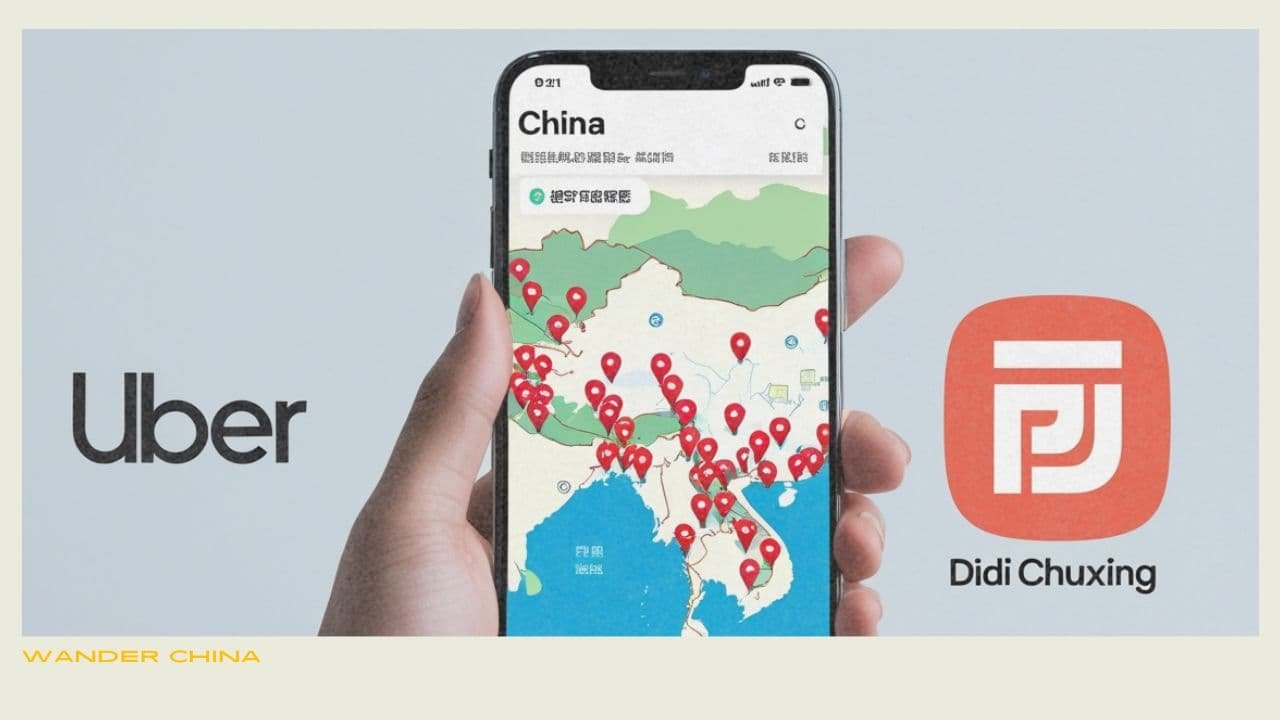Ride-Sharing in China: A Rapidly Evolving Landscape
Does Uber work in China? Learn about Uber's failed attempts and the dominant ridesharing apps.

Ride-sharing services have revolutionized transportation in urban areas worldwide, and China is no exception. With its massive population and rapidly growing cities, the demand for convenient and affordable mobility solutions has skyrocketed. Ride-sharing platforms like Uber, Didi Chuxing, and Cao Cao have emerged as game-changers, offering a seamless and technology-driven alternative to traditional taxis and public transportation.
In China, ride-sharing services have gained immense popularity due to their ability to address the challenges posed by traffic congestion, limited parking spaces, and the need for personalized transportation options. These platforms leverage advanced technologies, such as mobile apps, GPS tracking, and real-time data analysis, to connect riders with nearby drivers, providing a convenient and efficient way to navigate the bustling cities.
The rise of ride-sharing in China has not only transformed the way people commute but has also created new economic opportunities. Thousands of individuals have found employment as ride-share drivers, supplementing their incomes or even pursuing it as a full-time career. Additionally, the industry has fostered innovation and competition, driving companies to continuously improve their services and introduce new features to meet the evolving demands of Chinese consumers.
Uber’s Presence in China: A Bumpy Ride
Uber’s foray into the Chinese market was an ambitious endeavor, but one that ultimately faced significant hurdles and challenges. The ride-sharing giant entered China in 2013, hoping to tap into the country’s vast population and growing demand for transportation services. However, navigating the complex regulatory landscape and fierce competition proved to be a formidable task.
From the outset, Uber faced resistance from local authorities and established players in the Chinese market. The company’s aggressive expansion tactics and disruptive business model ruffled feathers among traditional taxi operators and government regulators. Concerns over passenger safety, driver qualifications, and compliance with local regulations plagued Uber’s operations in various Chinese cities.
Despite pouring billions of dollars into the Chinese market and offering steep discounts to attract riders, Uber struggled to gain a significant foothold. The company encountered a formidable rival in Didi Chuxing, a homegrown ride-sharing platform backed by deep-pocketed investors and well-connected with local authorities.
The battle between Uber and Didi escalated into a fierce price war, with both companies offering subsidized rides and incentives to lure drivers and customers. This unsustainable model drained resources and highlighted the intense competition in the Chinese market.
Ultimately, in 2016, Uber made the strategic decision to exit the Chinese market by selling its operations to Didi Chuxing in exchange for a stake in the combined entity. This move allowed Uber to cut its losses and focus on other global markets, while Didi solidified its dominance in China.
Despite its departure from China, Uber’s experience in the country served as a valuable lesson in navigating complex regulatory environments, adapting to local market dynamics, and the importance of building strong partnerships and relationships with local stakeholders.
Popular Ride-Hailing Apps in China
China has a vibrant ride-hailing market dominated by local players like Didi Chuxing, Cao Cao, and others. These apps have gained immense popularity and market share across the country, catering to the transportation needs of millions of Chinese citizens and visitors.
Didi Chuxing is the undisputed leader in the Chinese ride-hailing industry, holding a significant market share. Launched in 2012, Didi has grown to become a household name and a go-to app for many Chinese commuters. The app offers a wide range of services, including private cars, taxis, carpooling, and even bike-sharing options.
Cao Cao, formerly known as Kuaidi Dache, is another prominent player in the Chinese ride-hailing market. Cao Cao has a strong presence in several major cities and is known for its competitive pricing and efficient service. The app has also expanded its offerings to include services like food delivery and logistics.
In addition to these major players, there are several other ride-hailing apps operating in China, catering to specific regions or niches. However, Didi Chuxing and Cao Cao remain the dominant forces, capturing a substantial portion of the market share and continuously innovating to meet the evolving transportation needs of Chinese consumers.
Exploring Maps and Navigation Apps in China
China’s unique internet landscape has led to the development of locally-based mapping and navigation apps, while also restricting access to popular global services like Google Maps and Apple Maps. This section explores the availability and functionality of these apps within China.
Domestic mapping apps like Baidu Maps, AutoNavi, and Amap have emerged as the go-to solutions for Chinese users. These apps offer comprehensive coverage of China’s vast geography, including detailed maps of cities, roads, and points of interest. They also provide real-time traffic updates, route planning, and integration with various transportation modes like public transit, ride-sharing, and bike-sharing.

While Apple Maps is pre-installed on iOS devices sold in China, its functionality is limited compared to other regions. Apple has faced challenges in obtaining accurate mapping data and navigational information due to China’s strict data regulations. As a result, Apple Maps in China may lack certain features or have outdated information in some areas.
Google Maps, on the other hand, is entirely blocked in mainland China due to the country’s internet censorship policies. However, some users employ virtual private networks (VPNs) or other workarounds to access the service, albeit with potential performance and reliability issues.
It’s worth noting that the mapping and navigation landscape in China is constantly evolving, with new players and features emerging regularly. Local companies like Baidu, Alibaba, and Tencent are continuously investing in improving their mapping services, leveraging advanced technologies like artificial intelligence, machine learning, and crowdsourcing to enhance accuracy and user experience.
Cultural and Regulatory Factors Influencing Ride-Sharing and Mapping Apps in China
China’s cultural and regulatory environment presents unique challenges for global ride-sharing and mapping apps like Uber, Apple Maps, and Google Maps. Understanding the nuances of this landscape is crucial for these companies to succeed in the Chinese market.
Culturally, China has a strong preference for homegrown apps and services, driven by a sense of national pride and a desire to support domestic companies. This has given rise to local alternatives like Didi Chuxing for ride-sharing and Baidu Maps for navigation, which have gained significant market share and user loyalty.
Moreover, the Chinese government has implemented strict regulations and censorship policies that restrict the operations of foreign tech companies. These measures are often driven by concerns over data privacy, national security, and the desire to promote local industries. For instance, Google Maps has been effectively blocked in China since 2010, while Apple Maps faces limitations in terms of data collection and mapping accuracy.
Regulatory hurdles also extend to ride-sharing services, where companies must navigate complex licensing requirements, local partnerships, and compliance with transportation regulations that vary across different cities and provinces. Uber’s exit from the Chinese market in 2016, after facing intense competition from Didi and regulatory challenges, highlights the difficulties foreign companies face in this sector.
To succeed in China, global tech companies must carefully navigate these cultural and regulatory factors, often requiring localized strategies, partnerships with domestic firms, and a willingness to adapt to the unique demands of the Chinese market.
Navigating the Chinese Market: Challenges and Opportunities for Foreign Ride-Sharing and Mapping Companies
Foreign companies like Uber and Google Maps have faced significant challenges in penetrating the Chinese market due to regulatory hurdles, intense competition from domestic players, and the unique cultural and technological landscape of the country.
However, the sheer size and growth potential of the Chinese market make it an enticing opportunity for these companies. With a population of over 1.4 billion and rapidly urbanizing cities, the demand for efficient transportation and mapping services is immense.
Regulatory Challenges: The Chinese government has implemented strict regulations on foreign companies operating in the country, particularly in the technology and internet sectors. These regulations aim to protect domestic companies and maintain control over data and information flow within the country.
Competition from Local Players: Domestic companies like Didi Chuxing (for ride-sharing) and Baidu Maps (for mapping services) have a significant advantage in understanding the local market, cultural nuances, and consumer preferences. These companies have also received substantial support and investment from the Chinese government.
Cultural and Technological Differences: China’s unique cultural and technological landscape presents challenges for foreign companies. For example, the widespread use of mobile payment systems like WeChat Pay and Alipay, as well as the prevalence of super-apps that integrate multiple services, require foreign companies to adapt their business models and strategies.
Despite these challenges, foreign companies can explore opportunities by partnering with local companies, leveraging their technological expertise, and offering innovative services tailored to the Chinese market. Additionally, as China continues to open up its economy and seek international collaboration, the regulatory environment may become more favorable for foreign companies in the future.
User Experiences with Ride-Sharing and Mapping Apps in China
When it comes to ride-sharing and mapping apps in China, the landscape is quite different from what you might be used to in other parts of the world. While global giants like Uber and Google Maps have struggled to gain a foothold in the Chinese market, local players like Didi Chuxing and Baidu Maps have emerged as dominant forces.
For many travelers and expats in China, these local apps have become indispensable tools for navigating the country’s vast cities and transportation networks. However, the user experience can vary greatly depending on factors such as location, language proficiency, and familiarity with the apps’ interfaces.
One common theme among user reviews is the appreciation for the convenience and affordability of Didi Chuxing, China’s leading ride-hailing platform. With its extensive network of drivers and various service options (including private cars, taxis, and shared rides), Didi has become a go-to choice for many locals and visitors alike. Users praise the app’s user-friendly interface, efficient booking process, and competitive pricing.
On the other hand, some users have reported challenges with language barriers and occasional communication issues with drivers, especially in smaller cities or more remote areas. Additionally, concerns have been raised about safety and regulation within the ride-sharing industry in China, prompting calls for stricter oversight and better training for drivers.
When it comes to mapping and navigation apps, Baidu Maps is often lauded for its accuracy and comprehensive coverage of even the most obscure locations in China. Users appreciate the app’s real-time traffic updates, voice navigation, and integration with other services like ride-hailing and restaurant listings.
However, some users have criticized Baidu Maps for its cluttered interface and occasional glitches or inaccuracies, particularly in rapidly developing urban areas. There have also been concerns about data privacy and the app’s reliance on collecting user information.
For foreign visitors and expats, one of the biggest challenges with using local apps like Didi and Baidu Maps is the language barrier. While many apps offer English versions, the translations can sometimes be imperfect or lack certain features available in the Chinese versions. This can lead to frustration and a steeper learning curve for non-Chinese speakers.
Overall, the user experiences with ride-sharing and mapping apps in China highlight the unique challenges and opportunities of navigating the country’s vast and rapidly evolving digital landscape. While local apps offer convenience and tailored services, users must also navigate language barriers, regulatory concerns, and varying levels of user-friendliness.
Ride-Sharing and Mapping Apps: The Future Landscape in China
The ride-sharing and mapping app industries in China are poised for significant transformations in the coming years. As the world’s most populous country and a thriving technology hub, China presents unique opportunities and challenges that will shape the future of these sectors.
One potential trend is the increasing integration of artificial intelligence (AI) and machine learning technologies into ride-sharing and mapping apps. AI could be leveraged to optimize route planning, predict demand patterns, and enhance the overall user experience. Additionally, autonomous vehicles may eventually disrupt the traditional ride-sharing model, introducing new business opportunities and regulatory considerations.
Moreover, the growing emphasis on sustainability and environmental consciousness could drive the adoption of electric vehicles (EVs) and shared mobility solutions within the ride-sharing industry. Companies may incentivize the use of EVs or introduce innovative car-sharing models to reduce carbon emissions and alleviate traffic congestion in urban areas.
In the mapping app sector, we may witness the emergence of more immersive and interactive experiences. Augmented reality (AR) and virtual reality (VR) technologies could revolutionize the way users navigate and explore their surroundings, blending digital information with the physical world. This could open up new avenues for location-based services, advertising, and tourism experiences.
Furthermore, the increasing availability of high-resolution satellite imagery and advanced data analytics could enhance the accuracy and detail of mapping apps. Real-time traffic updates, personalized routing options, and seamless integration with other smart city initiatives could become standard features, improving urban mobility and transportation efficiency.
Privacy and data security will remain critical concerns as these industries evolve. Companies will need to prioritize robust data protection measures and transparent data handling practices to maintain user trust and comply with evolving regulations.
Lastly, the potential for cross-industry collaborations and partnerships could drive innovation in both sectors. Ride-sharing companies may collaborate with mapping app providers to offer integrated services, while mapping apps could partner with local businesses and tourism organizations to enhance location-based experiences.
Overall, the future of ride-sharing and mapping apps in China is poised for exciting developments driven by technological advancements, changing consumer preferences, and a focus on sustainability and urban mobility solutions.
Using Ride-Sharing and Mapping Apps in China
For travelers and expats in China, navigating the country’s vast cities and transportation systems can be a daunting task. While ride-sharing giants like Uber and mapping services like Google Maps are ubiquitous in many parts of the world, their availability and functionality in China are limited due to regulatory restrictions and competition from domestic alternatives.
To ensure a smooth and hassle-free experience, it’s essential to familiarize yourself with the popular local apps and services. Here are some tips and recommendations for using ride-sharing and mapping apps in China:
Ride-Sharing Apps
Didi Chuxing, the Chinese counterpart of Uber, dominates the ride-sharing market in China. This app offers a variety of services, including private cars, taxis, and shared rides. It’s user-friendly, with options for English and other language interfaces, making it accessible to foreigners.
Another popular option is Cao Cao Mobility, which operates in several major cities and offers competitive rates. Both Didi and Cao Cao accept various payment methods, including credit cards, mobile wallets, and cash.
Mapping and Navigation Apps
While Google Maps is accessible in China, its functionality is limited due to censorship and restrictions on mapping data. Instead, consider using Baidu Maps or Amap, two widely-used Chinese mapping apps that provide accurate and up-to-date information on traffic conditions, public transportation routes, and points of interest.
These apps also offer features like voice navigation, offline maps, and integration with ride-sharing services, making them indispensable tools for getting around China.
Tips for Using Local Apps
- Download the necessary apps before your trip and familiarize yourself with their interfaces and features.
- Ensure you have a stable internet connection or download offline maps for your destination to avoid connectivity issues.
- Learn a few basic Mandarin phrases or have a translation app handy, as some local drivers may have limited English proficiency.
- Be prepared to provide detailed addresses or landmarks, as some locations may not be accurately mapped or easily recognized by the apps.
- Consider purchasing a local SIM card or a portable Wi-Fi hotspot to ensure reliable internet access while on the go.
By embracing the local ride-sharing and mapping apps, you’ll not only have a more seamless and efficient travel experience but also gain valuable insights into the Chinese tech ecosystem and cultural nuances.
Understanding Ride-Sharing and Mapping Apps in China
China’s ride-sharing and mapping app landscape is unique and ever-evolving. While global giants like Uber and Google Maps have struggled to gain a foothold, domestic players have emerged to meet the country’s massive demand for transportation and navigation services. To truly grasp the intricacies of this market, it’s essential to explore the key factors that have shaped its current state.
The sheer size of China’s population and the rapid urbanization of its cities have fueled an insatiable need for efficient mobility solutions. However, regulatory hurdles, data localization requirements, and the dominance of local tech titans have created significant barriers for foreign companies. Domestic firms, deeply attuned to the nuances of the Chinese market, have capitalized on this opportunity, offering localized services tailored to the preferences and needs of Chinese consumers.
Moreover, the Chinese government’s emphasis on developing a robust digital infrastructure and promoting homegrown innovation has played a pivotal role in nurturing domestic players. Initiatives such as the “Internet Plus” and “Made in China 2025” strategies have provided a fertile ground for local companies to thrive, while also encouraging the adoption of cutting-edge technologies like artificial intelligence and big data analytics.
As the landscape continues to evolve, it’s crucial to stay abreast of the latest developments, emerging players, and shifting consumer preferences. The ride-sharing and mapping app market in China is a dynamic and fascinating microcosm of the country’s broader technological and economic ambitions, offering valuable insights into the interplay between innovation, regulation, and consumer behavior.
Recent Posts
- Top Guangzhou Watch Markets to Visit in 2025: The Ultimate Insider’s Guide
- My Guide to the Best Home Appliance Markets in Guangzhou
- Guangzhou Garment Wholesale Markets: My Local Guide
- Best Hotel in Guangzhou: A Comprehensive Guide for Foreign Travelers
- Guangzhou Food Guide: Must-Try Dishes & Top Restaurants (2025 Edition)
Recent Comments
Top Guangzhou Watch Markets to Visit in 2025: The Ultimate Insider’s Guide
I visited the top watch markets in Guangzhou to show you where...
My Guide to the Best Home Appliance Markets in Guangzhou
Explore top offline home appliance markets in Guangzhou with local tips, Chinese...
Best Hotel in Guangzhou: A Comprehensive Guide for Foreign Travelers
Find the best hotels in Guangzhou—from luxury icons to local favorites. Updated...
Guangzhou Food Guide: Must-Try Dishes & Top Restaurants (2025 Edition)
I’m an expat in Guangzhou sharing the best local dishes, top restaurants...







Leave a comment